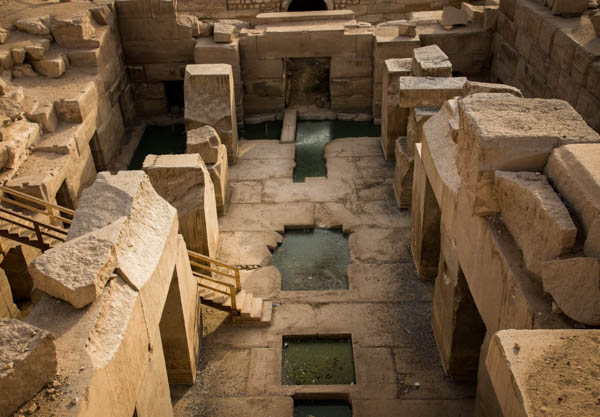
By 5400 BC Abydos was a thriving city, and two thousand years later pre-dynastic pharaohs were still building shrines, temples and mortuaries. Seti I added his own masterpiece in the thirteenth century BC, an elegant temple featuring a series of interconnected halls and side chambers, covered from floor to ceiling in exquisite friezes, murals and hieroglyphs. Still, people had long been coming here to witness another wonder.
Twelve thousand years ago the region bore no resemblance to what it is today. The climate was wetter, it sustained a lush landscape, and to the west, where now lies an endless desert, there existed an inland sea, much of which drained into the Atlantic when the events that generated the great flood, and closed the Younger Dryas, overhauled the region. Referring to an older source, Diodorus of Sicily describes how it "disappeared from sight in the course of an earthquake, when those parts of it which lay toward the ocean were torn asunder," leaving behind the Sahara. A small saltwater lake at Siwa is all that remains.
The course of the Nile was also seven miles closer to the town, its waters reaching another kind of temple, named for the Egyptian god of resurrection Osiris — the Osirion. In terms of construction and style, the temple bears no resemblance to Seti’s. It is stark yet hauntingly beautiful, a fine example of simplicity and economy of line expressed with heavyset blocks of red granite, ferried from a quarry two hundred miles away. The construction logistics pose a conundrum for any engineer, yet the Osirion belongs to a remote age, created with the sole intent of defying time.
The Osirion consists of two rows of columns connected by substantial architraves upon which once stood a voluminous stone roof. These are poised on a raised rectangular platform surrounded by a deep moat cut into the stone; two ascending staircases lead out of the water and onto the platform, where lie two sunken rectangular pools.
The surrounding courtyard itself is one massive and impenetrable wall of 25-foot thick red sandstone, fitted without mortar, with corner stones cut and angled much like they are in Cuzco. Seventeen side chambers fit into the wall and face the central court. The plan of the courtyard bears a passing resemblance to the head of Pachacamac carved above the Sun Door at Tiwanaku. It's a passing observation for sure, but the same cannot be said for the knobs carved in relief on sections of the courtyard wall, for they are identical to those in the Andean temples.
There are no inscriptions inside the Osirion, no dedications, no name to identify its creator, only a set of hieroglyphs carved into the wall adjoining Seti’s temple and added during the pharaoh’s time.
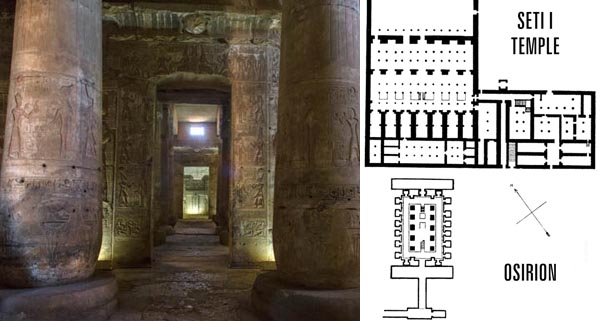
Seti I's temple bears no visual relationship to the Osirion below ground, and its plan veers left, a violation of temple protocol.
Until recently the Osirion was believed to be a type of underground chamber fitted inside hollowed bedrock, an extension of Seti’s temple. If so it represents a complete departure from orthodox temple design. However, a geologic appraisal contradicts this opinion. In ancient times the level of the Nile was fifty feet lower than today, and its waters touched the Osirion. But when North Africa was subjected to major flooding between 10,500-8000 BC, layers of Nile silt gradually compacted and rose inch by inch until they surrounded and covered the Osirion, in other words, the temple was originally a freestanding structure on a floodplain. Legend has it that people once reached the Osirion by boat and navigated its interior — an opinion expressed by Henri Frankfort, one of the early archaeologists at Abydos — but as the Nile crept ever more eastwards, it eventually became necessary to connect the Osirion to the river with a long canal.
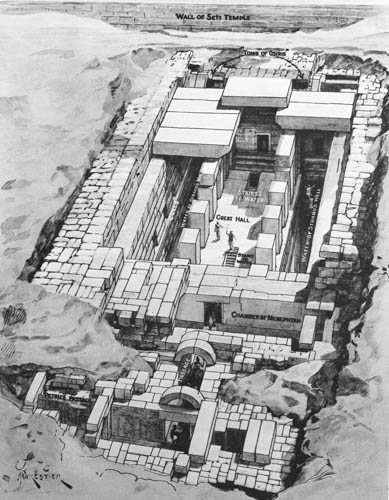
Reconstruction of the Osirion after its rediscovery in 1914.
The Osirion has two counterparts downriver at Giza — the Sphynx Temple and the Valley Temple, all constructed with identical megalithic blocks of red granite (those of the Sphynx Temple were looted for building material), using the same clean, graphic layout, devoid of inscription. The Giza temples too were reached by boat when the waters of the Nile lapped at their respective entrances. The intermediate walls of the Valley Temple are made from massive blocks of limestone quarried from the sphynx enclosure next door and are clearly eroded by water, lots of water. Since it has been convincingly argued that the sphynx itself was carved to face its counterpart in the sky, the constellation Leo on the spring equinox c.10,400 BC, ostensibly the two sites are contemporaries of each other. Furthermore, the enclosure in which this lion sits was also weathered by extensive flooding and rainfall when a pluvial climate predominated northeast Africa, the epoch prior to 10,000 BC. Thus by weathering and design alone all the above temples share the same period.
Returning to the Osirion, there is the question of why so many temples and shrines appear in its vicinity of yet none relate to it, as though it was no longer visible by pre-dynastic times, so when pharaohs came here to mark their devotion they were merely honoring the sanctity of place. By the time Seti I came to build his temple, he may have rediscovered the Osirion because his temple follows the same orientation but stops short of the underground structure before resuming to the left and creating an L-shape, forcing the most holy of chapels to be placed sideways to the body of the temple, a complete violation of temple protocol. The only feasible explanation for such a drastic measure is that Seti rediscovered the Osirion, and superimposed his own building before the weight broke through the chamber beneath during construction.
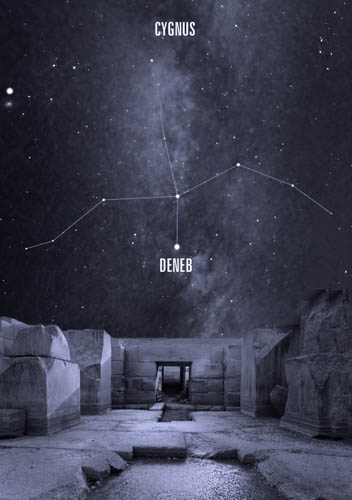
Deneb in Cygnus, winter solstice c.10,500 BC, as seen from the front entrance (rear of temple pictured)
Could the enigmatic structure be a remnant of an antediluvian age? With its raised platform surrounded by a water channel, the Osirion depicts the primeval island Ta Neterw, the original home from which gods such as the Aku Shemsu Hor (Shining Ones, Followers of Horus) emerged. To determine exactly when it was built we must turn to archaeo astronomy.
Time and again I have stood dumbstruck in the Osirion. Its orientation has vexed me for years, for it does not face the solstices or equinox, nor does it relate to the pole star, nor any obvious object in the sky. Myth states this to be a resting place of Osiris, even if the association, as in so many cases in the ancient world, is metaphoric. Osiris is the classic depiction of the dismembered hero who ascends the Milky Way to reach the origin of souls — typically the Pole Star or the belt of Orion — and whilst in the Otherworld he is reconstituted by his consort Isis.
A look at the night sky at the time of Seti I produces absolutely no relationship to any stellar object, it seems the pharaoh broke yet another convention by ignoring the sky-ground relationship essential to the foundation of the temple and its sacred function, as expressed in the maxim As Above So Below. Seti was an astute student of temple protocol, he wouldn’t have made such an obvious mistake. Since his temple is aligned to the same axis at the Osirion, it follows that he may have may have attempted to revive the importance of its predecessor.
I turned my focus to Orion, the constellation with which Osiris is intimately associated. Perhaps this obvious clue would yield a sky-ground relationship, but no such relationship exists, not unless the Earth was upside down 14,000 years ago and even so it would be impossible to calculate.
Only in the epoch of 10,000 BC do connections begin emerge, when the constellation Cygnus appears in full upright ascent over the horizon, in conjunction with the axis of the temple, the entrance framing its brightest star Deneb. As does the Milky Way, forming a vertical river for Cygnus to ride towards the vault of the sky. This correlation took place on the spring equinox c.10,500 BC, and again on the winter solstice.
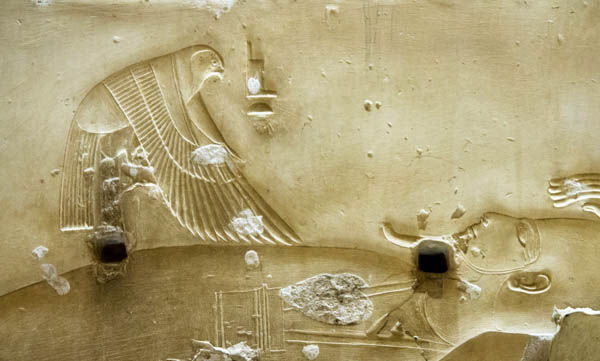
Isis as a kite hawk above Osiris, as pictured in Seti's temple.
By way of validation, the sky goddess Nut, who is identified with the Milky Way, is painted as a naked female spread across the sky on the ceiling of the Osirion's north-eastern chamber, her legs formed by the bifurcation at Deneb in Cygnus. The symbol couldn’t be more apt. Cygnus itself was regarded as a kite hawk, and it is likely that Egyptian text references to the "kite of Osiris" may have had this constellation in mind. His bride Isis, who took on the form of this hawk when resurrecting souls, is depicted in Seti’s later temple with wings outspread — a symbol of protection, and demonstrating her ability to fan the breath of immortality into those whom she oversaw, specifically her consort Osiris. For this to occur, the soul of the hero must reside in the pole star, described by ancient cultures as the region of regeneration, a place protected by seven great akus (souls), each represented by the seven circumpolar stars, Deneb being one. Egyptologist Toby Wilkinson explains this in context of Egyptian ideology: "Circumpolar stars are a very good metaphor for the afterlife because when viewed, they never seem to set: they simply rotate around the pole star. They are the undying stars, or in Egyptian terminology, the Indestructibles, a perfect destination for the soul.”
The Indestructibles or ikhemu-sek (the ones not knowing destruction) was a name created by Egyptian astronomers, although the idea of these stars protecting a portal of regeneration is shared among indigenous cultures.
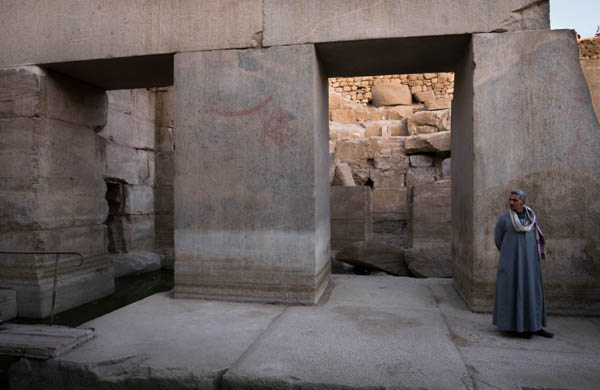
The Osirion feature's Egypts largest megalithic masonry.
Indestructible? Portal of regeneration? What apt epiteths for a temple named for the god of rebirth and designed to outlast time! Incidentally the derivative of aku is akh — a person filled with inner spiritual radiance, a Shining One — pre-flood gods such as the Urukehu of New Zealand and Easter Island, Viracocha and his Hayhuaypanti, and the Anunaki sages. Could any of these seafaring gods have been responsible for building the Osirion? Probably, based on a direct correlation between the Osirion and the position of Deneb c.10,500 BC, when this brightest of stars not only rose along the axis of the temple but, due to the effects of precession, it had by then also taken up its position as one of the Indestructibles.
The effective pole star during the course of this era, the Younger Dryas, was Vega. In Arabic tradition Vega is An-nasz-al-waki, the falling eagle, named after its apparent swooping motion in the sky. Perhaps it is more than ironic that a number of world traditions describe wise men being forewarned of the impending deluge by an eagle or a hawk. According to the Kamilaroi of Australia, for example, when the deluge was caused by the eagle-hawk Pundjel, two people survived by climbing a tree. The metaphor describes how the couple saved themselves through attachment to the World Tree representing the cosmic pole linking the three levels of creation, the knowledge of which guarantees their survival as seeds of a regenerated humanity.
That’s quite the symbol of rebirth. Much like the Osirion.
© Freddy Silva 2019